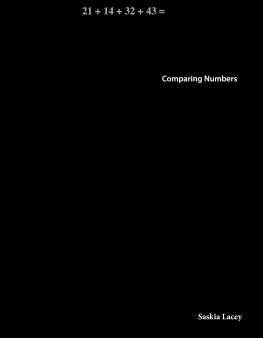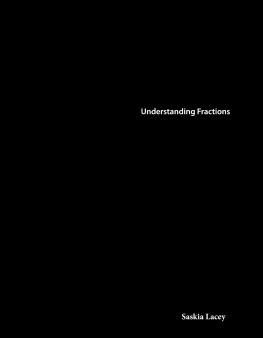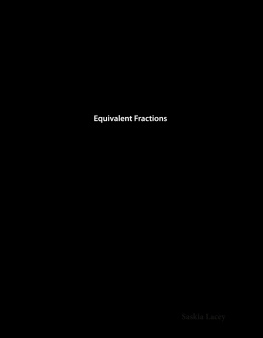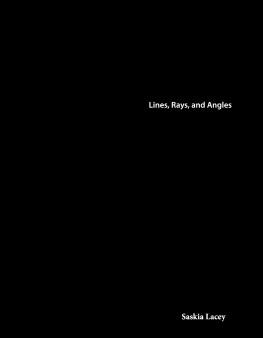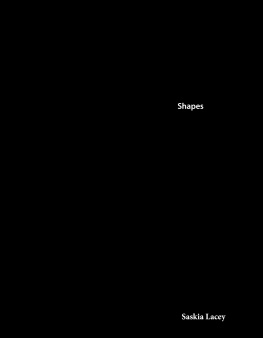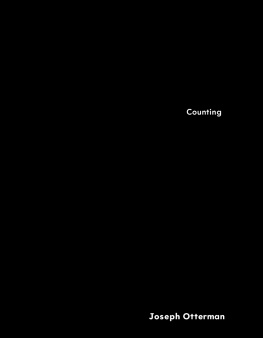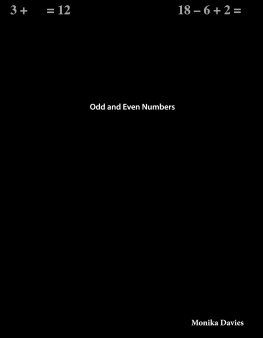Saskia Lacey - Spectacular Sports: Martial Arts: Comparing Numbers
Here you can read online Saskia Lacey - Spectacular Sports: Martial Arts: Comparing Numbers full text of the book (entire story) in english for free. Download pdf and epub, get meaning, cover and reviews about this ebook. year: 2018, publisher: Teacher Created Materials, genre: Children. Description of the work, (preface) as well as reviews are available. Best literature library LitArk.com created for fans of good reading and offers a wide selection of genres:
Romance novel
Science fiction
Adventure
Detective
Science
History
Home and family
Prose
Art
Politics
Computer
Non-fiction
Religion
Business
Children
Humor
Choose a favorite category and find really read worthwhile books. Enjoy immersion in the world of imagination, feel the emotions of the characters or learn something new for yourself, make an fascinating discovery.
- Book:Spectacular Sports: Martial Arts: Comparing Numbers
- Author:
- Publisher:Teacher Created Materials
- Genre:
- Year:2018
- Rating:5 / 5
- Favourites:Add to favourites
- Your mark:
- 100
- 1
- 2
- 3
- 4
- 5
Spectacular Sports: Martial Arts: Comparing Numbers: summary, description and annotation
We offer to read an annotation, description, summary or preface (depends on what the author of the book "Spectacular Sports: Martial Arts: Comparing Numbers" wrote himself). If you haven't found the necessary information about the book — write in the comments, we will try to find it.
Spectacular Sports: Martial Arts: Comparing Numbers — read online for free the complete book (whole text) full work
Below is the text of the book, divided by pages. System saving the place of the last page read, allows you to conveniently read the book "Spectacular Sports: Martial Arts: Comparing Numbers" online for free, without having to search again every time where you left off. Put a bookmark, and you can go to the page where you finished reading at any time.
Font size:
Interval:
Bookmark:
0covercover.xhtmlcover1page0001page0001.xhtml22page0002page0002.xhtmlSpectacular Sports Martial Arts Comparing Numbers33page0003page0003.xhtml44page0004page0004.xhtmlTable of Contents A Fierce Fighter 4 Different Styles 6 Put in the Time 26 Problem Solving 28 Glossary 30 Index 31 Answer Key 3255page0005page0005.xhtmlA Fierce Fighter Meet Bruce Lee! He was a martial arts master. His fighting style was lightning fast. Bruce Lee starred in action movies, such as Enter the Dragon. People around the world loved watching Bruce Lee. But Bruce Lee was not the first martial artist. Martial arts have been around for thousands of years. There are many styles of fighting. Chances are, you may have heard of a few! Does kung fu (KUHNG FOO) sound familiar? How about sumo (SOO-moh)? Those are just a couple, but there are many more to discover. Bruce Lee66page0006page0006.xhtmlStudents practice kung fu.77page0007page0007.xhtmlDifferent Styles Each style of martial arts is unique. But all styles reward discipline and hard work. Kung Fu Kung fu is thousands of years old. This Chinese martial art centers on defense. Fighters defend themselves with different stances, or poses. From there, they kick and block their opponents. Kung fu is more than a martial art. The phrase kung fu means skill. A person must have certain skills to do kung fu. He or she can work hard to develop these skills. A boy practices a kung fu pose.88page0008page0008.xhtmlA boy practices a side kick. A girl practices a ban mabu (bahn mah-BOO), or half-horse stance.99page0009page0009.xhtmlMany kung fu stances are named after animals. Each kung fu stance has its benefits. The snake stance allows someone to make quick attacks. Their hands strike like a snake. The tiger stance is based on strength. Martial artists who use this stance must be agile (AH-jile). Like tigers, they are powerful and fast. The tiger stance uses open- hand blows. In this stance, fighters hands look like claws! tiger stance1010page0010page0010.xhtmlLET'S EXPLORE MATH Imagine that a large group of martial arts students have been asked to choose their favorite kung fu stances. The place value charts show the number of students who chose the dragon stance and the snake stance. Which stance did more students choose? How do you know? Dragon Stance Hundreds Tens Ones Snake Stance Hundreds Tens Ones1111page0011page0011.xhtmlSumo Sumo is another martial art style. It comes from Japan. Like kung fu, it has a long history. People have watched sumo for hundreds of years. In the early days, fights were violent. For a while, sumo wrestling was banned. There are two ways to win a sumo match. One wrestler may push the other out of the ring. Or, a wrestler may push the other to the ground. Wrestlers may only touch the ground with their feet. If any other parts of their bodies touch the ground, the match is over. In sumo wrestling, the ring is called a dohyo (doh-YOH).1212page0012page0012.xhtmlHakuh Sho is one of the worlds best sumo wrestlers.1313page0013page0013.xhtmlMany people think that in sumo, the larger fighter always wins. But that is not true! Sumo is about more than size and strength. To win, fighters must be fast. Like kung fu, they must be agile, too. Today, sumo is a big part of life in Japan. There are many matches every year. The best wrestler has a special name. This wrestler is called the grand champion. A sumo wrestler gets ready to compete.1414page0014page0014.xhtmlLET'S EXPLORE MATH Imagine tickets are being sold for a sumo wrestling competition. Adult tickets cost 875 yen (money in Japan). Youth tickets cost 575 yen. 1. Draw a number line like the one below. Plot 875 and 575. 0 100 200 300 400 500 800 700 1, 000 900 600 2. Which ticket costs more? How do you know? Sumo wrestlers compete in Japan.1515page0015page0015.xhtmlCapoeira In Brazil, people practice a martial arts style called capoeira (kap-oo-AIR-uh). At these bouts, fighting and music mix. Some people in the crowd sing. Other people pound drums or ring bells. In the middle of the crowd, two fighters kick, punch, and cartwheel in time to the music. But capoeira is not just fun and games. Like all martial artists, these fighters work hard. They have to train to master their moves.1616page0016page0016.xhtmlCapoeira athletes train to the beat of the drum.1717page0017page0017.xhtmlBefore capoeira bouts happen, fighters go to school. Thats right! There are schools for this style of martial arts. These schools first opened in Brazil. But now, there are capoeira schools all over the world. Students learn how to move to the beat of the music. They also learn how to keep from getting hit. A student practices at a capoeira school.1818page0018page0018.xhtmlCapoeira students in Sweden learn how to train safely.1919page0019page0019.xhtmlKendo Like sumo, kendo (KEN-doh) is from Japan. This style came from the samurai (SAM-uh-righ). These warriors prepared for their fights by battling each other. They started kendo as a way to perfect their skills. Kendo fighters use weapons. Samurai used swords made of strong metals. Katana (kuh-TAW-nuh) swords were known for being sharp. Today, fighters use swords made from wood. They are called shinai (SHEE-nigh). These swords let them train without getting hurt. A kendo fighter trains with a shinai sword.2020page0020page0020.xhtmlLET'S EXPLORE MATH A katana blade can be about 73 centimeters long. A shinai can be about 120 centimeters long. 1. Write 73 as a total of tens and ones. 2. Write 120 as a total of hundreds, tens, and ones. 3. Choose the best phrase to complete the comparison. 73 _____ 120. A. is greater than B. is less than C. is equal to 4. Choose the best symbol to complete the comparison. 120 73 A. > B. < C. = A samurai warrior rests his hand on a katana blade.2121page0021page0021.xhtmlKendo matches take place in large squares. All fighters wear the same uniforms, called kendogi (ken-DOH-ghee). They wear jackets, wide pants, masks, and gloves. Fighters also wear clothes to protect their chests and waists. To score points, fighters must strike each other in certain places. For example, a point is given when the shinai strikes the top of the head. To win a point, the fighter must call out where they are striking. The first one to score two points wins. A fighter earns a point for a strike to the head.2222page0022page0022.xhtmlLET'S EXPLORE MATH Imagine you are reading about kendo match results. You count 112 matches won with a strike to the body and 121 matches won with a strike to the wrist. Complete each comparison with >, <, or =. 1. 112 121 2. 1 hundred + 1 ten + 2 ones 1 hundred + 21 ones 3. 112 + 10 121 4. 112 121-10 A kendo fighter poses in his kendogi.2323page0023page0023.xhtmlKarate The martial art of karate (kuh-RAH-tee) is close to five hundred years old. It came from East Asia. At the time, weapons were banned. But people still wanted a way to defend themselves. So, they came up with karate. Karate means empty hands. That means that fighters do not use weapons. The style stayed in East Asia for many years. About one hundred years ago, karate schools opened in Japan. From there, karate spread. Today, it is one of the most practiced styles in the world. Kids practice blocking punches in karate class.2424page0024page0024.xhtmlA girl practices her side kick.2525page0025page0025.xhtmlFighters wear jackets and pants, called karategi (kuh-RAH-tee-ghee). These clothes are usually white. Karate fighters also wear belts. The color of the belt shows the skill of the fighter. New students wear white belts. Karate masters wear black belts. The way to win a karate match is to strike as hard as you can. That is why fighters practice by punching and kicking pads and pieces of wood. Some fighters can even break bricks or thick pieces of wood with their bare hands or feet. Two karate fighters wear gloves to keep each other safe.2626page0026page0026.xhtmlA karate fighter breaks a block of wood. karate belts2727page0027page0027.xhtmlPut in the Time It takes years for martial artists to perfect their craft. They must train for hours every day. So, if martial arts excite you, put in the time! People all over the world practice martial arts. Choose which style seems like the most fun to learn. It may be kendo, kung fu, or even sumo. Then, start practicing!2828page0028page0028.xhtmlThese children train to be the next sumo grand champion.2929page0029page0029.xhtmlProblem Solving Kung fu films are known for their action. They are filled with actors who do thrilling martial arts moves. Imagine you are watching a kung fu film with your family. Everyone wants to know which move is used most often. Each time actors face off, a family member counts the number of kicks, strikes, or blocks. Each of them shows the number a different way. Use the information to the right to answer the questions and make comparisons. 1. Write three-digit numbers to show the number of kicks, strikes, and blocks in the movie. 2. Choose numbers to complete each comparison. 3. Which move happened most often? How do you know? 4. Which move happened least often? How do you know?3030page0030page0030.xhtmlKicks Strikes Blocks3131page0031page0031.xhtmlGlossary agile able to move easily and quickly banned not allowed bouts sporting contests defense the act of protecting someone or something from attack discipline a way of training meant to improve behavior martial arts any one of the forms of fighting and self-defense that are practiced as sports opponents people, teams, or groups who compete against each other strike to hit in a powerful way unique unlike anything else3232page0032page0032.xhtmlIndex Brazil capoeira Enter the Dragon Japan karate kendo kung fu Lee, Bruce samurai Sho, Hakuho stances sumo swords3333page0033page0033.xhtmlAnswer Key Let's Explore Math page 9 : More students chose the dragon stance; Answers will vary but may include that both place value charts show 2 hundreds, but the dragon stance chart shows 5 tens whereas the snake stance chart only shows 4 tens. page 13 : 1. 575 875 2. The adult ticket costs more; Answers will vary but may include that the adult ticket costs 875 yen, which is farther to the right on the number line than the youth ticket at 575 yen. page 19 : 1. 70 + 3 2. 100 + 20 + 0 3. B; 73 is less than 120 4. A; 120 > 73 page 21 : 1. <; 112 < 121 2. <; 1 hundred + 1 ten + 2 ones < 1 hundred + 21 ones 3. >; 112 + 10 > 121 4. >; 112 > 121 10 Problem Solving 1. Kicks 314; Strikes 275; Blocks 140 2. a. Answers will vary but may include 314 > 275, 314 > 140, or 275 > 140. b. Answers will vary but may include 314 > 275, 314 > 140, or 275 > 140. c. Answers will vary but may include 275 < 314, 140 < 314, or 140 < 275. d. Answers will vary but may include 275 < 314, 140 < 314, or 140 < 275. 3. Kicks happened the most often; Answers will vary but may include that kicks has a 3 in the hundreds place, whereas strikes only has a 2 and blocks only has a 1 in the hundreds place. 4. Blocks happened the least often; Answers will vary but may include that 140 is less than 275, and 140 is less than 314.3434page0034page0034.xhtmlMath Talk 1. When comparing three-digit numbers, is the number with the most hundreds always the greatest? Why or why not? 2. How are the comparisons 243 > 234 and 234 < 243 similar and different? 3. How can you use a number line to compare numbers? 4. What are the greatest and least numbers you can make using the digits 3, 7, and 2 once in each number? 5. Luke has been to 89 karate classes. June has been to 123 karate classes. Luke says he has been to more classes than June because 8 and 9 are greater than 1, 2, and 3. What do you think about Lukes reasoning? Why? 6. When might a martial arts master need to know who has more or less of something?35
Next pageFont size:
Interval:
Bookmark:
Similar books «Spectacular Sports: Martial Arts: Comparing Numbers»
Look at similar books to Spectacular Sports: Martial Arts: Comparing Numbers. We have selected literature similar in name and meaning in the hope of providing readers with more options to find new, interesting, not yet read works.
Discussion, reviews of the book Spectacular Sports: Martial Arts: Comparing Numbers and just readers' own opinions. Leave your comments, write what you think about the work, its meaning or the main characters. Specify what exactly you liked and what you didn't like, and why you think so.

